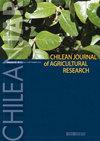Impact of different water management and microbe application on yield of rice cultivars under seawater intrusion areas of Indonesia
IF 1.5
4区 农林科学
Q2 AGRICULTURE, MULTIDISCIPLINARY
引用次数: 0
Abstract
Primary risk to rice (Oryza sativa L.) production is salinity intrusion and water scarcity, leading to a shortage of irrigation water and yield reduction. We examine the impactâs effects of alternate wetting and drying (AWD) vs. continuous flooding (CF) and microbe application on yields of three rice cultivars (Ciherang, Inpari 34 Salin Agritan, Inpari 35 Salin Agritan) grown under slight and moderate soil salinity in the dry season (DS) 2017 and 2018. Under slight soil salinity, AWD and CF had nonsignificant difference in grain yield. Under a moderate soil salinity level, there was a substantial decrease in grain yield (8.2%), number of productive tillers, seeds panicle-1, and weight of 1000 grains with the plants grown under AWD. Increased soil salinity levels resulted in lower yield reduction with microbial than without microbial treatments. âCiherangâ showed superiority over âInpari 34â and âInpari 35â under AWD at slight soil salinity. However, the yield reduction in the moderate salinity level was more remarkable for âCiherangâ (18.1%) than âInpari 34â and âInpari 35â (9.7%) as salinity-tolerant varieties. The AWD used almost one-third less irrigation supplement than CF. This greatly assists small farmers in reducing the additional cost of pumping water. On average, AWD improved total water productivity by 32.7% under slight and 20.4% under moderate soil salinity over CF. Here, we lay out the potential for small farmers in slight salinity lowlands areas of the northern coast of Java to apply AWD during the DS. Farmers could manage water efficiently to prevent further yield loss and improve farm profitably.印尼海水入侵区不同水分管理和微生物施用对水稻产量的影响
水稻(Oryza sativa L.)生产的主要风险是盐度入侵和缺水,导致灌溉用水短缺和产量下降。研究了干湿交替(AWD)、连续淹水(CF)和施用微生物对2017年和2018年旱季(DS)轻度和中度土壤盐分条件下生长的3个水稻品种(赤禾朗、Inpari 34 Salin agitan、Inpari 35 Salin agitan)产量的影响。在轻度土壤盐分条件下,AWD和CF对籽粒产量影响不显著。在中等土壤盐分水平下,AWD处理的植株籽粒产量、有效分蘖数、穗数、千粒重均显著下降(8.2%)。土壤含盐量的增加导致微生物处理的减产幅度低于没有微生物处理的减产幅度。在轻度土壤盐分条件下,在AWD条件下,’iherang’优于’Inpari 34’和’Inpari 35’。但耐盐品种中盐水平下产量下降幅度较大的品种为:’齐赫兰格’(18.1%),而耐盐品种’Inpari 34’和‘’Inpari 35’(9.7%)。AWD比CF少使用了近三分之一的灌溉补剂,这极大地帮助小农减少了抽水的额外成本。平均而言,与CF相比,AWD在轻度土壤盐度下提高了32.7%,在中度土壤盐度下提高了20.4%。在这里,我们列出了爪哇北部海岸轻度盐低地地区的小农在DS期间施用AWD的潜力。农民可以有效地管理水资源,以防止进一步的产量损失,提高农场的利润。
本文章由计算机程序翻译,如有差异,请以英文原文为准。
求助全文
约1分钟内获得全文
求助全文
来源期刊

Chilean Journal of Agricultural Research
AGRICULTURE, MULTIDISCIPLINARY-AGRONOMY
CiteScore
3.10
自引率
11.80%
发文量
60
审稿时长
6-12 weeks
期刊介绍:
ChileanJAR publishes original Research Articles, Scientific Notes and Reviews of agriculture, multidisciplinary and agronomy: plant production, plant protection, genetic resources and biotechnology, water management, soil sciences, environment, agricultural economics, and animal production (focused in ruminant feeding). The editorial process is a double-blind peer reviewing, Editorial Office checks format, composition, and completeness, which is a requirement to continue the editorial process. Editorial Committee and Reviewers evaluate relevance and scientific merit of manuscript.
 求助内容:
求助内容: 应助结果提醒方式:
应助结果提醒方式:


